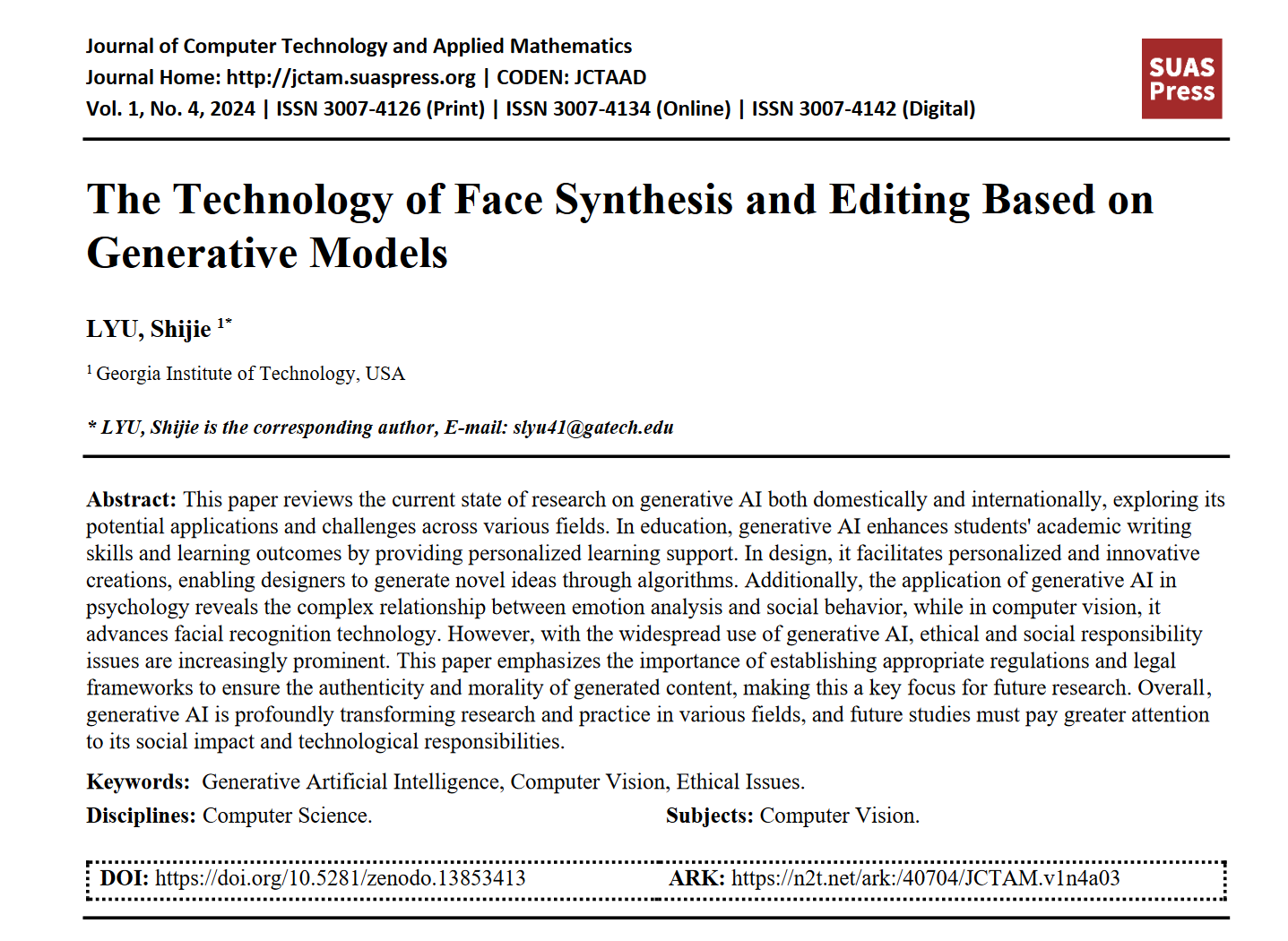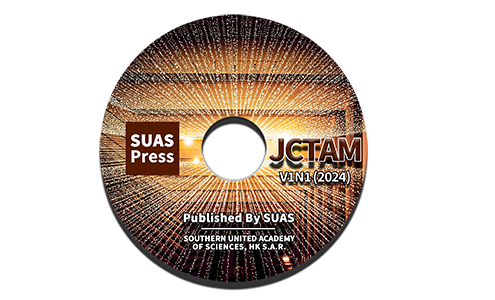The Technology of Face Synthesis and Editing Based on Generative Models
DOI:
https://doi.org/10.5281/zenodo.13853413ARK:
https://n2t.net/ark:/40704/JCTAM.v1n4a03Disciplines:
Computer ScienceSubjects:
Computer VisionReferences:
39Keywords:
Generative Artificial Intelligence, Computer Vision, Ethical IssuesAbstract
This paper reviews the current state of research on generative AI both domestically and internationally, exploring its potential applications and challenges across various fields. In education, generative AI enhances students' academic writing skills and learning outcomes by providing personalized learning support. In design, it facilitates personalized and innovative creations, enabling designers to generate novel ideas through algorithms. Additionally, the application of generative AI in psychology reveals the complex relationship between emotion analysis and social behavior, while in computer vision, it advances facial recognition technology. However, with the widespread use of generative AI, ethical and social responsibility issues are increasingly prominent. This paper emphasizes the importance of establishing appropriate regulations and legal frameworks to ensure the authenticity and morality of generated content, making this a key focus for future research. Overall, generative AI is profoundly transforming research and practice in various fields, and future studies must pay greater attention to its social impact and technological responsibilities.
References
Mo, Y. ., Qin, H., Dong, Y., Zhu, Z., & Li, Z. (2024). Large Language Model (LLM) AI Text Generation Detection based on Transformer Deep Learning Algorithm. International Journal of Engineering and Management Research, 14(2), 154–159. https://doi.org/10.5281/zenodo.11124440
Hao Qin, & Zhi Li. (2024). A Study on Enhancing Government Efficiency and Public Trust: The Transformative Role of Artificial Intelligence and Large Language Models. International Journal of Engineering and Management Research, 14(3), 57–61. https://doi.org/10.5281/zenodo.12619360
Hao Qin, & Li, Z. (2024). Precision in Practice: Enhancing Healthcare with Domain-Specific Language Models. Applied Science and Engineering Journal for Advanced Research, 3(4), 28–33. https://doi.org/10.5281/zenodo.13253336
Qu, M. (2024). High Precision Measurement Technology of Geometric Parameters Based on Binocular Stereo Vision Application and Development Prospect of The System in Metrology and Detection. Journal of Computer Technology and Applied Mathematics, 1(3), 23–29. https://doi.org/10.5281/zenodo.13366612
Wang, D. (Ed.). (2016). Information Science and Electronic Engineering: Proceedings of the 3rd
International Conference of Electronic Engineering and Information Science (ICEEIS 2016), January 4-5, 2016, Harbin, China. CRC Press.
Vivek Tomar & Nitin Kumar. (2024). Single-sample face and ear recognition using virtual sample generation with 2D local patches. The Journal of Supercomputing (prepublish), 1-26.
(2024). Contactless Smart Attendance System Using Facial Recognition and QR Code. International Journal of Engineering and Advanced Technology (IJEAT) (6)
(2024). Nabla Works Corp. Launches 'Face Recognition Access Solution'. Wireless News
Emma Bou Hanna, Sebastian Partarrieu, Arnaud Berenbaum, Stéphanie Allassonnière & Florent L. Besson. (2024). Exploring de-anonymization risks in PET imaging: Insights from a comprehensive analysis of 853 patient scans. Scientific Data (1), 932-932.
Sebastian Ludyga,Fabienne Bruggisser,Rahel Leuenberger,Toru Ishihara,Keita Kamijo,Mark Brotzmann... & Markus Gerber. (2024). Acute effects of exercise on gaze fixation and affective response inhibition in children with autism spectrum disorder: A randomized cross-over study.. Autism research : official journal of the International Society for Autism Research
Yang Wang,Fan Xie,Chuanxin Zhao,Ao Wang,Chang Ma,Shijia Song... & Lijun Zhao. (2024). Robust face recognition model based sample mining and loss functions. Knowledge-Based Systems 112330-112330.
Usman Muhammad, Mourad Oussalah & Jorma Laaksonen. (2024). Saliency-based video summarization for face anti-spoofing. Pattern Recognition Letters 190-196.
(2024). Nabla Works Corp. Introduces 'Face Recognition Access Solution'. Manufacturing Close - Up
Xiaoqun LIU, Mei LIU & Ning LI. (2024). Dual vision visual fusion improved YOLO-V7 intelligent elevator face recognition model. Journal of Optics (prepublish), 1-13.
Juan Cai, Qiangqiang Duan, Min Long, Le Bing Zhang & Xiangling Ding. (2024). Feature Interaction-Based Face De-Morphing Factor Prediction for Restoring Accomplice’s Facial Image. Sensors (17), 5504-5504
Parker L J ,Richard M V ,Acabá A , et al. Negotiating Meaning with Machines: AI's Role in Doctoral Writing Pedagogy [J]. International Journal of Artificial Intelligence in Education, 2024, (prepublish): 1-21.
Kalinin A ,Jafari A A ,Avots E , et al. Generative AI-based style recommendation using fashion item detection and classification [J]. Signal, Image and Video Processing, 2024, (prepublish): 1-11.
He Z ,Wang H Y ,Zhang J . Generative AIBIM: An automatic and intelligent structural design pipeline integrating BIM and generative AI [J]. Information Fusion, 2025, 114 102654-102654.
He Z ,Wang H Y ,Zhang J . Generative AIBIM: An automatic and intelligent structural design pipeline integrating BIM and generative AI [J]. Information Fusion, 2025, 114 102654-102654.
Rodrigo M ,Cuevas C ,García N . Comprehensive comparison between vision transformers and convolutional neural networks for face recognition tasks [J]. Scientific Reports, 2024, 14 (1): 21392-21392.
Gaur S ,Pandey M ,Himanshu . Realization of Facial Recognition Technology for Attendance Monitoring Through Biometric Modalities Employing MTCNN Integration [J]. SN Computer Science, 2024, 5 (7): 862-862.
Moore N K ,Nesmith L B ,Zwemer U D , et al. Search efforts and face recognition: the role of expectations of encounter and within-person variability in prospective person memory [J]. Cognitive Research: Principles and Implications, 2024, 9 (1): 63-63.
Śliwiak P ,Shah A A S . Text-to-text generative approach for enhanced complex word identification [J]. Neurocomputing, 2024, 610 128501-128501.
Qiao, Y., Li, K., Lin, J., Wei, R., Jiang, C., Luo, Y., & Yang, H. (2024). Robust domain generalization for multi-modal object recognition. arXiv preprint arXiv:2408.05831.
Li, K., Chen, J., Yu, D., Dajun, T., Qiu, X., Jieting, L., ... & Ni, F. (2024). Deep Reinforcement Learning-based Obstacle Avoidance for Robot Movement in Warehouse Environments. arXiv preprint arXiv:2409.14972.
Li, K., Wang, J., Wu, X., Peng, X., Chang, R., Deng, X., ... & Hong, B. (2024). Optimizing Automated Picking Systems in Warehouse Robots Using Machine Learning. arXiv preprint arXiv:2408.16633.Charlie H
He, C., Liu, M., Wang, Z., Chen, G., Zhang, Y., & Hsiang, S. M. (2022). Facilitating Smart Contract in Project Scheduling under Uncertainty—A Choquet Integral Approach. Construction Research Congress 2022, 930–939.
Chen, G., Liu, M., Zhang, Y., Wang, Z., Hsiang, S. M., & He, C. (2023). Using Images to Detect, Plan, Analyze, and Coordinate a Smart Contract in Construction. Journal of Management in Engineering, 39(2), 1–18.
Wu, T., Zaitian, G., Wang, Q., & Gao, F. (2024). Scalable Distance-based Multi-Agent Relative State Estimation via Block Multiconvex Optimization. arXiv preprint arXiv:2405.20883.
Zhao, G., Wu, T., Chen, Y., & Gao, F. (2024). Learning Speed Adaptation for Flight in Clutter. IEEE Robotics and Automation Letters.
Wu, T., Chen, Y., Chen, T., Zhao, G., & Gao, F. (2024). Whole-Body Control Through Narrow Gaps From Pixels To Action. arXiv preprint arXiv:2409.00895.
Bačić, B., Feng, C., & Li, W. (2024). JY61 IMU SENSOR EXTERNAL VALIDITY: A FRAMEWORK FOR ADVANCED PEDOMETER ALGORITHM PERSONALISATION. ISBS Proceedings Archive, 42(1), 60.
Yu, P., Cui, V. Y., & Guan, J. (2021, March). Text classification by using natural language processing. In Journal of Physics: Conference Series (Vol. 1802, No. 4, p. 042010). IOP Publishing.
Xu, Y., Lin, Y. S., Zhou, X., & Shan, X. (2024). Utilizing emotion recognition technology to enhance user experience in real-time. Computing and Artificial Intelligence, 2(1), 1388-1388.
Luo, M., Zhang, W., Song, T., Li, K., Zhu, H., Du, B., & Wen, H. (2021, January). Rebalancing expanding EV sharing systems with deep reinforcement learning. In Proceedings of the Twenty-Ninth International Conference on International Joint Conferences on Artificial Intelligence (pp. 1338-1344).
Luo, M., Du, B., Zhang, W., Song, T., Li, K., Zhu, H., ... & Wen, H. (2023). Fleet rebalancing for expanding shared e-Mobility systems: A multi-agent deep reinforcement learning approach. IEEE Transactions on Intelligent Transportation Systems, 24(4), 3868-3881.
Fan, H., Li, K., Li, X., Song, T., Zhang, W., Shi, Y., & Du, B. (2019). CoVSCode: a novel real-time collaborative programming environment for lightweight IDE. Applied Sciences, 9(21), 4642.
Sun, Y., & Ortiz, J. (2024). Machine Learning-Driven Pedestrian Recognition and Behavior Prediction for Enhancing Public Safety in Smart Cities. Journal of Artificial Intelligence and Information, 1, 51-57.

Downloads
Published
How to Cite
Issue
Section
ARK
License
Copyright (c) 2024 The author retains copyright and grants the journal the right of first publication.

This work is licensed under a Creative Commons Attribution 4.0 International License.


















